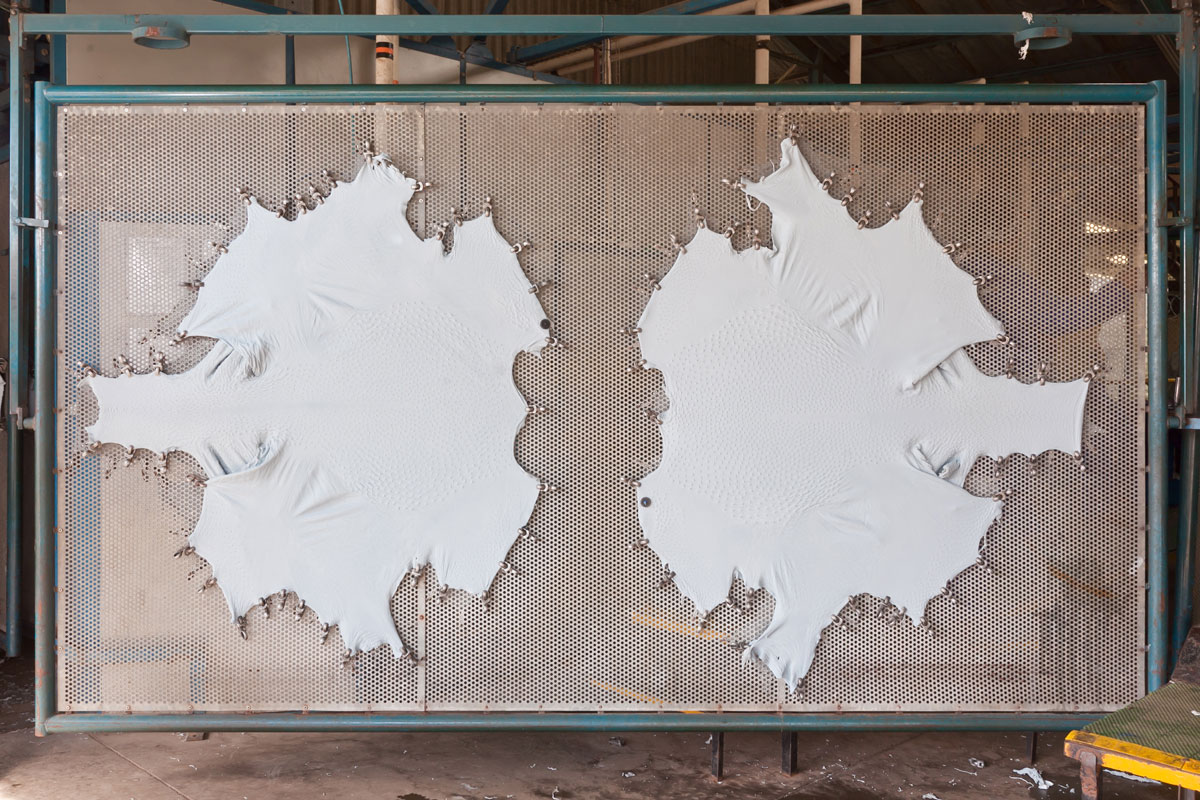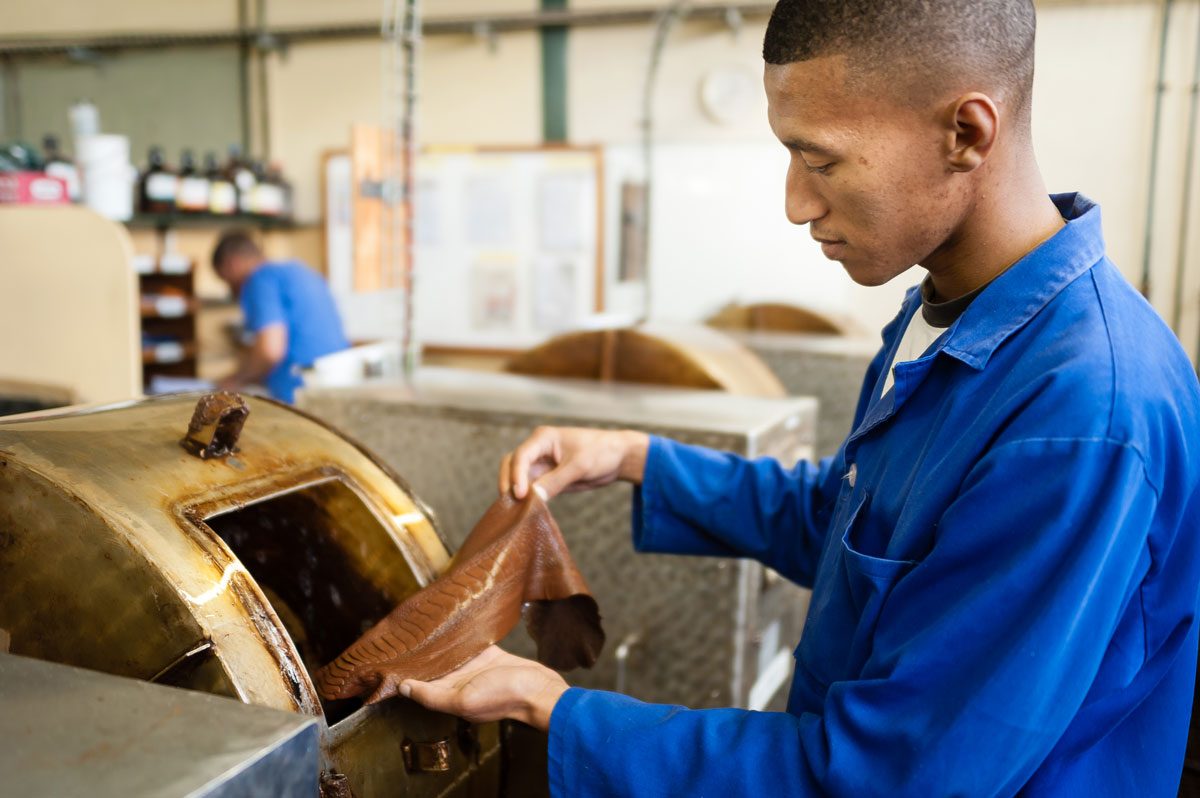SOUTH AFRICAN OSTRICH LEATHER
The uniquely natural look and feel, the wearing properties, and consistent supply of South African ostrich leather have established an impeccable reputation among the international fashion leaders of the world. Not restricted to top class fashion garments and accessories, South African ostrich leather has also carved a niche in luxury automotive upholstery and bespoke precious leather furniture. These products now utilise the decades of knowledge and skills incorporated into tanned skins for exceptional finished articles. Ostrich leather is unusually strong and scuff resistant whilst remaining durable and soft; thus, allowing a myriad of uses limited only by imagination.
At first haute couture was the platform for ostrich leather, but now the top echelon of the internationally famous fashion houses includes this unequalled leather in their collections, thereby enhancing the sense of exclusivity and uniqueness of their creations. Hollywood’s red carpet is often shown graced by the glitterati of the day carrying exquisite ostrich leather handbags.
Unique Qualities
Ostrich Leather is recognised through its unique texture and tactility. Two types of leather are produced from ostriches, namely body skin and leg skin. The ostrich body leather is made up of quilled and smooth areas, quaintly known as the “valley and hill” grain pattern.
The distinct quills are formed at the site where the feather grew, and give ostrich its characteristic three dimensional look and feel. In the “valley” or smooth area between the quills, striations similar to those found on the palm of the hand, contribute to the special character of ostrich leather. Traditionally only the fully quilled areas were used in products whereas modern usage tends to combine both areas to great effect.
The flat fibre structure of ostrich leather can be compared with a rope where fibres all run in the same direction resulting in exceptional strength. This is what gives ostrich its very high tear strength.
The leg skin is quite distinct from the body skin with its very different look and texture. The metatarsal creates a rather reptilian looking broad scale band running down the centre of the leg skin. The leg leather is naturally much smaller in size and best suited to small leather goods, boots and contrast detail on larger products, although it can also be stitched together to create larger panels. Most commonly sold in a high gloss glazed finish, leg skin leather is available in more matt effects as well.
Ostrich Leather Processing
The Manufacturing of leather is the oldest craft in the world which makes tanning the oldest industry. Tanning is the process of converting hides and pelts into leather. It was probably the first science on earth. Because of the craftsmanship and skills needed to tan successfully, it was probably also the oldest form of art in the world. The skins of wild animals have been vital commodities for mankind and the earliest “fashions” were made from animal skins.
Leather processing in South Africa has come a long way since the first ostrich skins were processed in 1970. Today South Africa has by far the most experienced and knowledgeable ostrich tanneries globally. While there are many methods of tanning, they all bring about the following changes in the raw hide or skin.
Tanned skin does not putrefy, even after drying and wetting. After drying, the tanned skin does not become a hard brittle material, but remains flexible and workable.
The chosen method of tanning is largely determined by how soft or hard, tight or stretchy, the resultant leather needs to be.The ostrich leather tanning process is quite complex and specialised as the fat of the bird is contained in the skin, unlike other animals where the fat is found mostly in the meat.
The connective fibre in ostrich leather is immensely dense, resulting in very high tear strength which make it ideal for footwear and furniture. The tanning process can be modified to create soft and pliable leather from which beautiful garments and furnishings can be made.
Tanning, Colouring,...
Ostrich Leather was first tanned in 1970 and exploded onto the haute couture scene in Europe. Initially the leather was fully pigmented, somewhat hard to the touch, and available in a very limited array of colours. Today no such limits apply. Colours are almost infinite, and the finishing much more varied and sophisticated. Current colour palettes include more than 550 beautiful colours.
Creating leather is primarily a three-part process.
1. Stabilise

Firstly, the raw skin is converted into a stable leather during the tanning process. The end use of the leather will dictate what tanning method is to be used; for instance, the tanning of light, soft and round garment leather will differ quite markedly from that of heavier shoe leather.
2. Colour

After tanning, colour is added, most often through drum dyeing. This ensures that colour is absorbed right throughout the thickness of the skin. Some colours need the addition of colour pigments, either to achieve the correct shade, or to enhance light fastness properties.
3. Finishing

Once the colour process has been completed the leather now just needs to be finished. This final process is where the “touch” and “look” are varied, using a wide range of differing finishing methods.
Ostrich leather is mostly produced in saddle finish. This has a dry, silky touch; however, other finishes can be used to create a more waxy or oily touch. The “look” too can be transformed in this process, while saddle finish has a very natural soft sheen, with a lively contrast between the quill and grain of the leather, metallic finish, for instance, will have a pearlised or fully metallic look.
Ostrich leather is mostly used in the manufacturing of luxury products where beauty and aesthetics are the main focus. Other uses, like automotive use, require more technical properties, such as very high light fastness; so, specific finishes have been developed to satisfy this criteria, allowing the introduction of ostrich leather into unusual and previously unexplored markets.
In conclusion, it is vital to communicate the end usage, colour and finish to obtain the absolute best ostrich leather for the intended creation.
